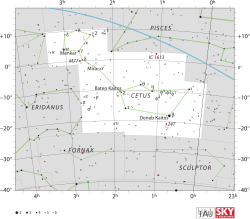鯨魚座κ1
| 观测资料 历元 J2000.0 | |
|---|---|
| 星座 | 鲸鱼座 |
| 星官 | 天囷 (胃宿) |
| 赤经 | 03h 19m 21.6960s[1] |
| 赤纬 | +03° 22′ 12.712″[1] |
| 视星等(V) | 4.84 |
| 特性 | |
| 光谱分类 | G5Vv[2] |
| U−B 色指数 | +0.185[3] |
| B−V 色指数 | +0.674[3] |
| 变星类型 | 可疑[4](天龙座BY型变星?) |
| 天体测定 | |
| 径向速度 (Rv) | +19.9[5] km/s |
| 自行 (μ) | 赤经:269.30 ± 0.24[1] mas/yr 赤纬:93.75 ± 0.22[1] mas/yr |
| 视差 (π) | 107.82 ± 0.27[1] mas |
| 距离 | 30.25 ± 0.08 ly (9.27 ± 0.02 pc) |
| 绝对星等 (MV) | 5.16[6] |
| 详细资料 | |
| 质量 | 1.037 ± 0.042[7] M☉ |
| 半径 | 0.95 ± 0.10[8] R☉ |
| 表面重力 (log g) | 4.51[9] |
| 亮度 | 0.85[10] L☉ |
| 温度 | 5,708[9] K |
| 金属量 [Fe/H] | +0.05[9] dex |
| 自转 | 9.2 days[10] |
| 自转速度 (v sin i) | 4.5[10] km/s |
| 年龄 | 300–400[11] Myr |
| 其他命名 | |
| 参考数据库 | |
| SIMBAD | 资料 |
| ARICNS | 资料 |
鲸鱼座κ1(κ1 Cet、κ1 Ceti)是在天球赤道上鲸鱼座内的一颗黄矮星,距离大约30光年[1]。这颗恒星被发现有着快速的旋转,周期大约为9天。虽然尚未证实有太阳系外行星环绕着这颗恒星,但鲸鱼座κ1被认为是拥有类地行星(像地球)的最佳候选者之一。这颗恒星也被怀疑是联星,但尚未得到证实[12]。也不要将它与距离远了约10倍的鲸鱼座κ2混淆。
恒星的伴星[编辑]
鲸鱼座κ1是一颗恒星,属于光谱类型G5Ve的黄矮星。这颗恒星的光谱自1943年起就担任恒星光谱分类的稳定锚点之一[13]。这颗恒星的质量大约与太阳一样,半径约为太阳的95%[8],但是亮度只有太阳的85%[10]。尚不清楚这颗恒星是否有比氢更重的元素,但确定它的铁元素含量介于太阳的98%至240%[来源请求]。鲸鱼座κ1比太阳年轻,年龄可能才只有8亿岁。
这颗恒星的自转非常快速,大约每9天就自转一周,据此推算的年龄相对更年轻,只有数亿年。由于星斑的变化,光度的变化周期与自转周期略有不同。在周期上的变化被认为是类似于太阳在不同纬度有着不同转速的差动自转。鲸鱼座κ1的星斑出现的纬度范围从10°到75°[10]。这颗恒星的磁场性质使它"非常适合在过去某一个关键点上的太阳与地球"[14]。
根据最近的假设,来自类太阳恒星的异常强烈的恒星闪焰,可能引发巨大行星磁场与紧邻轨道的恒星磁场产生交互作用。一些光谱类型从F8至G8,类似太阳的恒星,都曾被发现曾经历过被称为超级闪焰(日冕大量抛射)的磁场爆发,释放出的能量比曾经观测到的最巨大太阳闪焰强100至1,000万倍,巨大的磁能爆发使它们的亮度短期内增加了20倍[15]。在1998年,9颗类太阳恒星(包括鲸鱼座κ1)曾经产生平均约每世纪一次的超级闪焰。无论这些恒星自转得非常快,有密近的伴星,或是都很年轻。以前,未曾在太阳这一类型的主序星观察到这种大闪焰,但是它们通常都是一群黯淡的主序星,是被称为闪光星的带红色的M型矮星[来源请求]。
这颗恒星的空间速度是分量(U, V, W) = (−22.41, −4.27, −5.32) km/s[2],但还不知道它属于哪一个移动星群的成员[10]。
可能的行星系[编辑]
使用径向速度技术搜寻可能的伴星,但迄今尚未在鲸鱼座κ1周围寻获棕矮星或轨道在热区内环绕着的行星。鉴于经常发生的超级闪焰,即使在内侧有类地行星存在,也不太可能有类似地球的生物生存着。距离这颗恒星0.92天文单位(介于金星和地球相对于太阳的距离之间)是适合地球型行星(与液态水)稳定存的距离。在这个距离上的一颗行星,会有大约342天的轨道周期。
相关条目[编辑]
参考资料[编辑]
- ^ 1.0 1.1 1.2 1.3 1.4 1.5 van Leeuwen, F. Validation of the new Hipparcos reduction. Astronomy and Astrophysics. 2007, 474 (2): 653–664 [2016-08-11]. Bibcode:2007A&A...474..653V. arXiv:0708.1752
 . doi:10.1051/0004-6361:20078357. (原始内容存档于2019-12-07). Vizier catalog entry (页面存档备份,存于互联网档案馆)
. doi:10.1051/0004-6361:20078357. (原始内容存档于2019-12-07). Vizier catalog entry (页面存档备份,存于互联网档案馆)
- ^ 2.0 2.1 Montes, D.; et al. Late-type members of young stellar kinematic groups - I. Single stars. Monthly Notices of the Royal Astronomical Society. November 2001, 328 (1): 45–63. Bibcode:2001MNRAS.328...45M. arXiv:astro-ph/0106537
 . doi:10.1046/j.1365-8711.2001.04781.x.
. doi:10.1046/j.1365-8711.2001.04781.x.
- ^ 3.0 3.1 Cousins, A. W. J. Standardization of Broadband Photometry of Equatorial Standards. Circulars of the South African Astronomical Observatory. 1984, 8: 59. Bibcode:1984SAAOC...8...59C.
- ^ Kukarkin, B. V.; et al. Nachrichtenblatt der Vereinigung der Sternfreunde e.V. (Catalogue of suspected variable stars). Moscow, Academy of Sciences USSR Shternberg. 1981. Bibcode:1981NVS...C......0K.
- ^ Evans, D. S. The Revision of the General Catalogue of Radial Velocities. Batten, Alan Henry; Heard, John Frederick (编). Determination of Radial Velocities and their Applications, Proceedings from IAU Symposium no. 30. University of Toronto: International Astronomical Union. June 20–24, 1966. Bibcode:1967IAUS...30...57E.
- ^ Elgarøy, Øystein; Engvold, Oddbjørn; Lund, Niels, The Wilson-Bappu effect of the MgII K line - dependence on stellar temperature, activity and metallicity, Astronomy and Astrophysics, March 1999, 343: 222–228, Bibcode:1999A&A...343..222E
- ^ Boyajian, Tabetha S.; et al, Stellar Diameters and Temperatures. I. Main-sequence A, F, and G Stars, The Astrophysical Journal, February 2012, 746 (1): 101, Bibcode:2012ApJ...746..101B, arXiv:1112.3316
 , doi:10.1088/0004-637X/746/1/101
, doi:10.1088/0004-637X/746/1/101
- ^ 8.0 8.1 Walker, Gordon A. H.; et al. The Differential Rotation of κ1 Ceti as Observed by MOST. The Astrophysical Journal. April 2007, 659 (2): 1611–1622. Bibcode:2007ApJ...659.1611W. arXiv:0704.2204
 . doi:10.1086/511851.
. doi:10.1086/511851.
- ^ 9.0 9.1 9.2 Soubiran, C.; Bienaymé, O.; Mishenina, T. V.; Kovtyukh, V. V. Vertical distribution of Galactic disk stars. IV. AMR and AVR from clump giants. Astronomy and Astrophysics. March 2008, 480 (1): 91–101. Bibcode:2008A&A...480...91S. arXiv:0712.1370
 . doi:10.1051/0004-6361:20078788.
. doi:10.1051/0004-6361:20078788.
- ^ 10.0 10.1 10.2 10.3 10.4 10.5 Gaidos, E. J.; Henry, G. W.; Henry, S. M. Spectroscopy and Photometry of Nearby Young Solar Analogs. The Astronomical Journal. 2000, 120 (2): 1006–1013. Bibcode:2000AJ....120.1006G. doi:10.1086/301488.
- ^ Mamajek, Eric E.; Hillenbrand, Lynne A. Improved Age Estimation for Solar-Type Dwarfs Using Activity-Rotation Diagnostics. The Astrophysical Journal. November 2008, 687 (2): 1264–1293. Bibcode:2008ApJ...687.1264M. arXiv:0807.1686
 . doi:10.1086/591785.
. doi:10.1086/591785.
- ^ Hartkopf, W. I.; McAlister, H. A., Binary stars unresolved by speckle interferometry. III, Astronomical Society of the Pacific, January 1984, 96: 105−116, Bibcode:1984PASP...96..105H, doi:10.1086/131309
- ^ Garrison, R. F., Anchor Points for the MK System of Spectral Classification, Bulletin of the American Astronomical Society, December 1993, 25: 1319 [2012-02-04], Bibcode:1993AAS...183.1710G, (原始内容存档于2019-06-25)
- ^ Ribas, Ignasi, Solar and Stellar Variability: Impact on Earth and Planets, Proceedings of the International Astronomical Union, IAU Symposium, Proceedings of the International Astronomical Union, February 2010, 264: 3–18, Bibcode:2010IAUS..264....3R, arXiv:0911.4872
 , doi:10.1017/S1743921309992298
, doi:10.1017/S1743921309992298 |contribution=被忽略 (帮助) - ^ Schaefer, Bradley E.; King, Jeremy R.; Deliyannis, Constantine P. Superflares on Ordinary Solar-Type Stars. The Astrophysical Journal. 2000, 529 (2): 1026–1030. Bibcode:2000ApJ...529.1026S. arXiv:astro-ph/9909188
 . doi:10.1086/308325.
. doi:10.1086/308325.
外部链接[编辑]
- Kaler, Jim. KAPPA-1 CET. STARS. University of Illinois. [2008-07-09]. (原始内容存档于2008-09-07).
- Kappa Ceti. SolStation. [2008-07-09]. (原始内容存档于2021-05-08).
- Pulliam, Christine. Young sun-like star shows a magnetic field was critical for life on the early Earth. Harvard-Smithsonian Center for Astrophysics. March 16, 2016 [2016-03-16]. (原始内容存档于2021-03-04).
| |||||||||||||||||||||||||||||||||||||||||||||||||||||||||||||||||||||||||||||||||||||||
| |||||||||||||||||||||||||||

